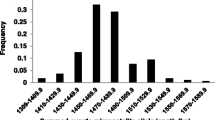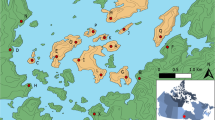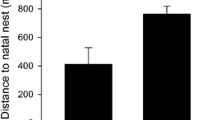Abstract
Dispersal propensity, reflecting one of the most decisive mammalian life history traits, has been suggested to vary heritably and to locally adapt to prevailing dispersal conditions in wild house mouse populations. Because individual dispersal propensity highly significantly covaries with the developmental timing of the onset of agonistic interactions between littermate brothers, we used agonistic onset as an endophenotype to explore the potential genetic basis of dispersal-related behavioral variation in male house mice. We found significant covariation of microsatellite marker compositions with the probability of fraternal pairs to exhibit agonistic relationships before the age of 2 months. In particular, the presence of two alleles associated with a serotonin transporter protein gene (Slc6a4) and a testosterone dehydrogenase gene (Cyp3a11), respectively, strongly covaried with the probability of early agonistic onset. These results are congruent with recent findings of microsatellite length polymorphisms marking regulatory variation of gene expression that is relevant for social behavior, including dispersal propensity development, in other mammals. Genetic variability for ontogenetic timing of agonistic onset would be in agreement with genotypic differentiation of the dispersive behavioral syndrome in natural populations that could lead to local adaptation.


Similar content being viewed by others
References
Bowler DE, Benton TG (2005) Causes and consequences of animal dispersal strategies: relating individual behaviour to spatial dynamics. Biol Rev 80:205–225
Cheung VG, Spielman RS, Ewen KG, Weber TM, Morley M, Burdick JT (2005) Mapping determinants of human gene expression by regional and genome-wide association. Nature 437:1365–1369
Clobert J, Danchin E, Dhondt AA, Nichols JD (2001) Dispersal. Oxford University Press, Oxford
Compaan JC, Hutchison JB, Wozniak A, Deruiter AJH, Koolhaas JM (1994) Brain aromatase activity and plasma testosterone levels are elevated in aggressive male mice during early ontogeny. Dev Brain Res 82:185–192
Contente A, Dittmer A, Koch MC, Roth J, Dobbelstein M (2002) A polymorphic microsatellite that mediates induction of PIG3 by p53. Nature Genet 30:315–320
Corti M, Rohlf FJ (2001) Chromosomal speciation and phenotypic evolution in the house mouse. Biol J Linn Soc 73:99–112
Gaines MS, McClenaghan LR (1980) Dispersal in mammals. Ann Rev Ecol Syst 11:163–169
Gerlach G (1996) Emigration mechanisms in feral house mice—a laboratory investigation of the influence of social structure, population density, and aggression. Behav Ecol Sociobiol 39:159–70
Goldstein DB, Schlötterer C (1999) Microsatellites. Evolution and applications. Oxford University Press, Oxford
Gottesman II, Gould TD (2003) The endophenotype concept in psychiatry: etymology and strategic intentions. Am J Psychiatry 160:636–645
Grafen A, Hails R (2002) Modern statistics for the life sciences. Oxford University Press, Oxford
Hammock EAD, Young LJ (2004) Functional microsatellite polymorphism associated with divergent social structure in vole species. Mol Biol Evol 21:1057–1063
Hammock EAD, Young LJ (2005) Microsatellite instability generates diversity in brain and sociobehavioral traits. Science 308:1630–1634
Hovatta I, Tennant RS, Helton R, Marr RA, Singer O, Redwine JM, Ellison JA, Schadt EE, Verma IM, Lockhart DJ, Barlow C (2005) Glyoxalase 1 and glutathione reductase 1 regulate anxiety in mice. Nature 438:662–666
Ims RA, Hjermann DØ (2001) Condition-dependent dispersal. Disperal. Oxford University Press, Oxford, pp 203–216
Insel TR, Wang ZX, Ferris CF (1994) Patterns of brain vasopressin receptor distribution associated with social organization in microtine rodents. J Neurosci 14:5381–5392
Kisdi É (2002) Dispersal: risk spreading versus local adaptation. Am Nat 159:579–596
Krackow S (2003) Motivational and heritable determinants of dispersal latency in wild male house mice (Mus musculus musculus). Ethology 109:671–689
Krackow S (2005) Agonistic onset during development differentiates wild house mouse males (Mus domesticus). Naturwissenschaften 92:78–81
Lank DB (1995) Genetic polymorphism for alternative mating behaviour in lekking male ruff, Phylomachus pugnax. Nature 378:59–62
Lesch KP, Meyer J, Glatz K, Flugge G, Hinney A, Hebebrand J, Klauck SM, Poustka A, Poustka F, Bengel D, Mossner R, Riederer P, Heils A (1997) The 5-HT transporter gene-linked polymorphic region (5-HTTLPR) in evolutionary perspective: alternative biallelic variation in rhesus monkeys. J Neural Transm 104:1259–1266
Lim MM, Wang Z, Olazábal DE, Ren X, Terwilliger EF, Young LJ (2004) Enhanced partner preference in a promiscuous species by manipulating the expression of a single gene. Nature 429:754–757
Müllenbach R, Lagoda PJL, Welter C (1989) An efficient salt-chlorophorm extraction of DNA from blood and tissues. Trends Genet 5:391
O’Riain MJ, Jarvis JUM, Faulkes CG (1996) A dispersive morph in the naked mole-rat. Nature 380:619–621
Parvinen K, Dieckmann U, Gyllenberg M, Metz JAJ (2003) Evolution of dispersal in metapopulations with local density dependence and demographic stochasticity. J Evol Biol 16:143–153
Piálek J, Hauffe HC, Searle JB (2005) Chromosomal variation in the house mouse. Biol J Linn Soc 84:535–563
Pocock MJO, Hauffe HC, Searle JB (2005) Dispersal in house mice. Biol J Linn Soc 84:565–583
Pulido F, Berthold P, Mohr G, Querner U (2001) Heritability of the timing of autumn migration in a natural bird population. Proc R Soc Lond B 268:953–959
Rifkin SA, Houle D, Kim J, White KP (2005) A mutation accumulation assay reveals a broad capacity for rapid evolution of gene expression. Nature 438:220–223
Rosenbrock H, Hagemeyer CE, Singec I, Knoth R, Volk B (1999) Testosterone metabolism in rat brain is differentially enhanced by phenytoin-inducible Cytochrome P450 isoforms. J Neurosci 11:597–604
Rusu AS, Krackow S (2005) Agonistic onset marks emotional changes and dispersal propensity in wild house mouse males (Mus domesticus). J Comp Psychol 119:58–66
Scantlebury M, Speakman JR, Oosthuizen MK, Roper TJ, Bennett NC (2006) Energetics reveals physiologically distinct castes in a eusocial mammal. Nature 440:795–797
Sih A, Bell AM, Johnson JC, Ziemba RE (2004) Behavioral syndromes: an integrative overview. Q Rev Biol 79:241–277
Sinervo B, Clobert J (2003) Morphs, dispersal behavior, genetic similarity, and the evolution of cooperation. Science 300:1949–1951
Sinervo B, Bleay C, Adamopoulou C (2001) Social causes of correlational selection and the resolution of a heritable throat color polymorphism in a lizard. Evolution 55:2040–2052
Stenseth NC, Lidicker WZ (1992) Animal dispersal. Small mammals as a model. Chapman & Hall, London
Trefilov A, Berard J, Krawczak M, Schmidtke J (2000) Natal dispersal in rhesus macaques is related to serotonin transporter gene promoter variation. Behav Genet 30:295–301
Wolf JB, Frankino WA, Agrawal AF, Brodie ED, Moore AJ (2001) Developmental interactions and the constituents of quantitative variation. Evolution 55:232–245
Acknowledgment
We are greatly indebted to E. ‘Garby’ Garbely, eventually transformed into Jari ‘The Lucky Man’ Garbely, who performed the microsatellite typing in our group, and Gerald Kerth for the genetics lab work supervision. Alan G. McElligott kindly reviewed the English. Financial support from German Research Foundation (Heisenberg programme KR1290/6), Swiss National Science Foundation (research grant 3100-59609), and Julius-Klaus-Stiftung Zürich is kindly acknowledged. The experiments were done under approval of the Kantonales Veterinäramt, Zürich, license numbers 164/99 and 127/2002.
Author information
Authors and Affiliations
Corresponding author
Additional information
Communicated by G. Wilkinson
Rights and permissions
About this article
Cite this article
Krackow, S., König, B. Microsatellite length polymorphisms associated with dispersal-related agonistic onset in male wild house mice (Mus musculus domesticus). Behav Ecol Sociobiol 62, 813–820 (2008). https://doi.org/10.1007/s00265-007-0507-y
Received:
Revised:
Accepted:
Published:
Issue Date:
DOI: https://doi.org/10.1007/s00265-007-0507-y




